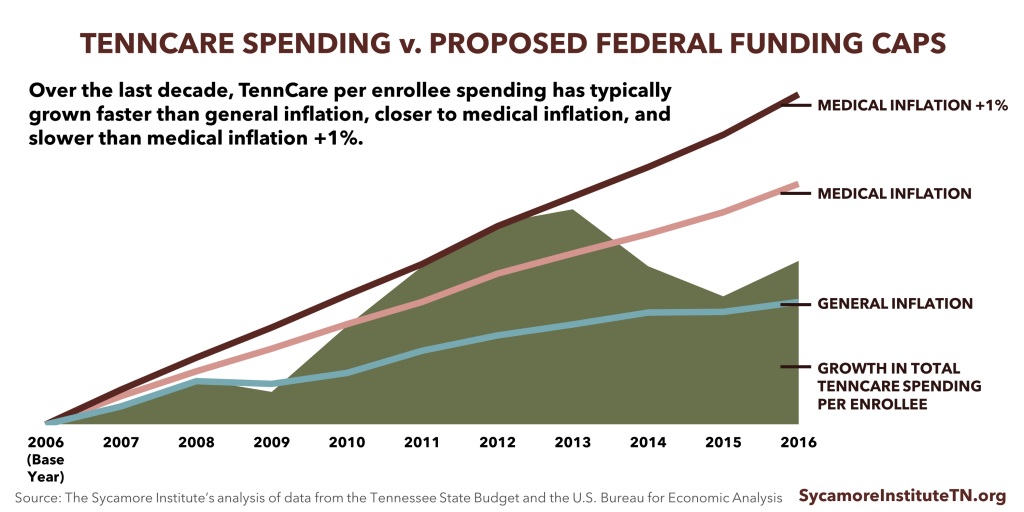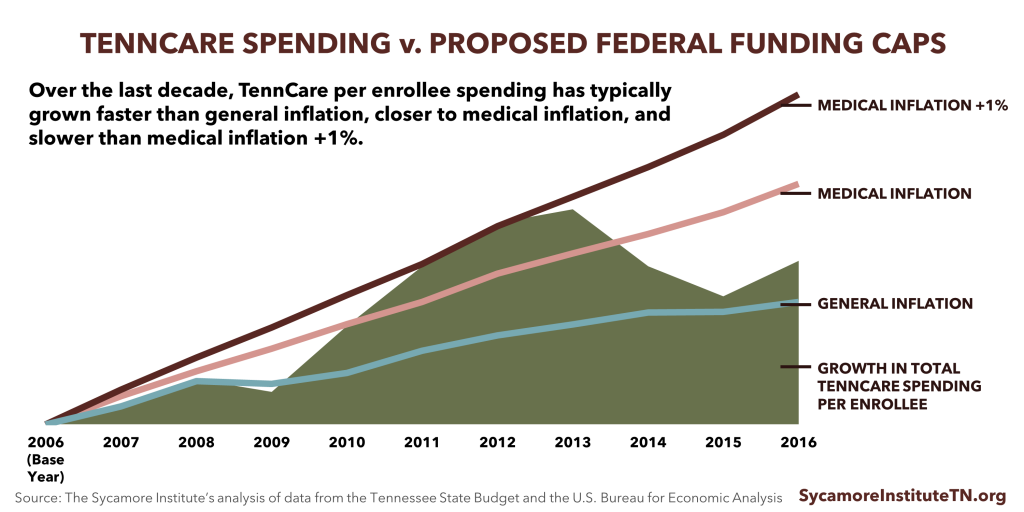The U.S. House and Senate bills to partially repeal and replace the Affordable Care Act (ACA) propose 3 different growth rates for caps on federal Medicaid funding to states. Each proposal aims to slow the growth of federal Medicaid spending but would place greater pressure on state budgets.
We looked at the last decade to see how these 3 growth rates compare with the historical growth of TennCare spending per capita. Here’s what we found.

Since 2006, TennCare per enrollee spending has typically grown faster than general inflation, closer to medical inflation, and slower than medical inflation +1%.
Now let’s look at how the House and Senate bills apply these 3 proposed growth rates.
How do the Medicaid per capita caps grow under each bill?
The House Bill
Beginning in 2020, the U.S. House bill sets annual caps on federal funding for state Medicaid programs based on 1) each state’s 2016 per enrollee spending, 2) medical inflation, and 3) enrollment in 5 enrollee categories.
- Caps for children and non-disabled adults would grow each year with medical inflation.
- Caps for the elderly and individuals with disabilities would grow with medical inflation + 1%.
The Senate Bill
Beginning in 2020, the U.S. Senate bill sets annual caps on federal funding for state Medicaid programs based on 1) each state’s per enrollee spending during any consecutive 8 quarters during the federal FY 2014 – FY 2017 period, 2) medical inflation, and 3) enrollment in 5 categories. The caps do not apply to children with disabilities.
- For 2020-2024, caps for children and non-disabled adults would grow each year with medical inflation.
- For 2020-2024, caps for the elderly and individuals with disabilities would grow with medical inflation + 1%.
- Beginning in 2025, caps for all enrollee categories would grow each year with general inflation.
- States that are 25% below or 25% above the national average in per enrollee spending could see their caps increase or decrease, respectively. Nationally, TennCare had the 8th lowest per enrollee costs for individuals with disabilities in federal FY 2011 but the 7th highest per enrollee costs for non-disabled adults.
What is general inflation?
Inflation (or general inflation) is the common name for the Consumer Price Index for All Urban Consumers (CPI-U). The CPI-U measures the average annual change in prices for goods and services purchased by average urban households. It includes everything from food and housing costs to medical care and education.
What is medical inflation?
Medical inflation is the medical care component of the CPI-U. Often called the CPI-M, medical inflation measures the average annual change in prices for prescription drugs, health insurance premiums, hospital and provider health care services, and medical equipment. It only tracks consumers’ out-of-pocket spending for these items.
Want more analysis of ACA repeal-and-replace efforts?
Budget Reconciliation and the Affordable Care Act (January 3, 2017)
Medicaid Reform 101: More Than Just Block Grants (January 26, 2017)
How U.S. House Medicaid Reforms Could Impact TennCare (March 10, 2017)
TennCare’s Federal Funding Under the AHCA (March 14, 2017)
AHCA vs. ACA: Tax Credits, Insurance Premiums, & the Big Picture (March 16, 2017)
Health Insurance Markets 101: Key Concepts that Influence Access and Affordability (April 5, 2017)
Reinsurance & High-Risk Pools: What Are They and Why Do They Matter for Tennessee (April 11, 2017)
Tennessee’s High-Risk Pool Experience (April 11, 2017)
How the U.S. House Health Bill Affects Tennessee (May 10, 2017)
Understanding Medicaid and TennCare: Key Concepts and Context to Know (June 1, 2017)
A Closer Look at the American Health Care Act’s Impact on Tennessee: Rural Health & Tennesseans with Disabilities (June 23, 2017)

